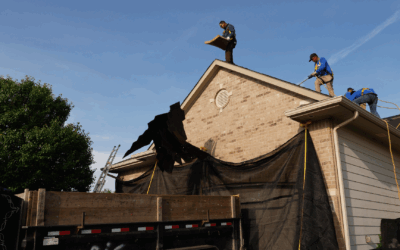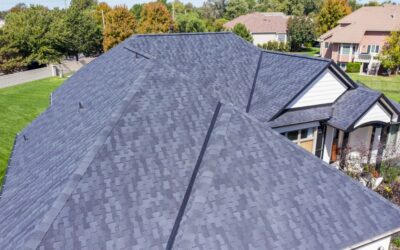Updated 08/22/2025
Attic ventilation might seem like a modern concern. It’s a necessity in modern building construction for a reason, but the challenges it addresses have been around for centuries. Heat has always risen, moisture has always lingered, and – in unventilated attic spaces – materials have always degraded. Before standardized building code existed, builders observed these physics problems and experimented with solutions, like atriums and cupulas. Their solutions are the predecessors for today’s ventilation standards.
Whether you’re looking into ventilation for an existing roof, considering ventilation upgrades for a new roof, or just curious about airflow in your home, understanding the importance of proper attic ventilation will help you prevent heat buildup and moisture problems in your home.
How Does Proper Attic Ventilation Work?
This article is part of a three-part series covering the importance of attic ventilation, the types of ventilation systems, and how to improve them. If you’d like a comprehensive breakdown of how proper attic ventilation works – including airflow mechanics, code requirements, and detailed design best practices – read our in-depth guide on how to improve attic ventilation here.
Here is a brief overview of the basics.
Attics need a way for air to enter (intake) and exit (exhaust). These must be balanced, which is measured by Net Free Area (NFA) – the total size of the openings air can move through. Balanced, proper attic ventilation follows a simple rule of thumb (more of a code requirement, really): one square foot of NFA for every 300 square feet of attic floor space.
Ventilation must also be balanced, with between 50-60 percent of NFA comprising intake and between 40-50 percent comprising exhaust. A 60:40 ratio of intake to exhaust is generally recommended, where possible. When intake and exhaust are not balanced, the system pulls in air from the wrong places, like trying to drink through a straw with a hole in it. Air stops exhausting properly, and myriad problems can result. Let’s look at the most common problems resulting from inadequate attic ventilation.
The Effects of Poor Attic Ventilation
Degraded Roofing Materials
Roofing materials depend on proper attic ventilation for optimal performance. The roof isn’t a cover: it’s a system. Without proper attic ventilation, the system’s solution for excessive heat and moisture is absent. Here’s how common roof failures are caused by inadequate ventilation.
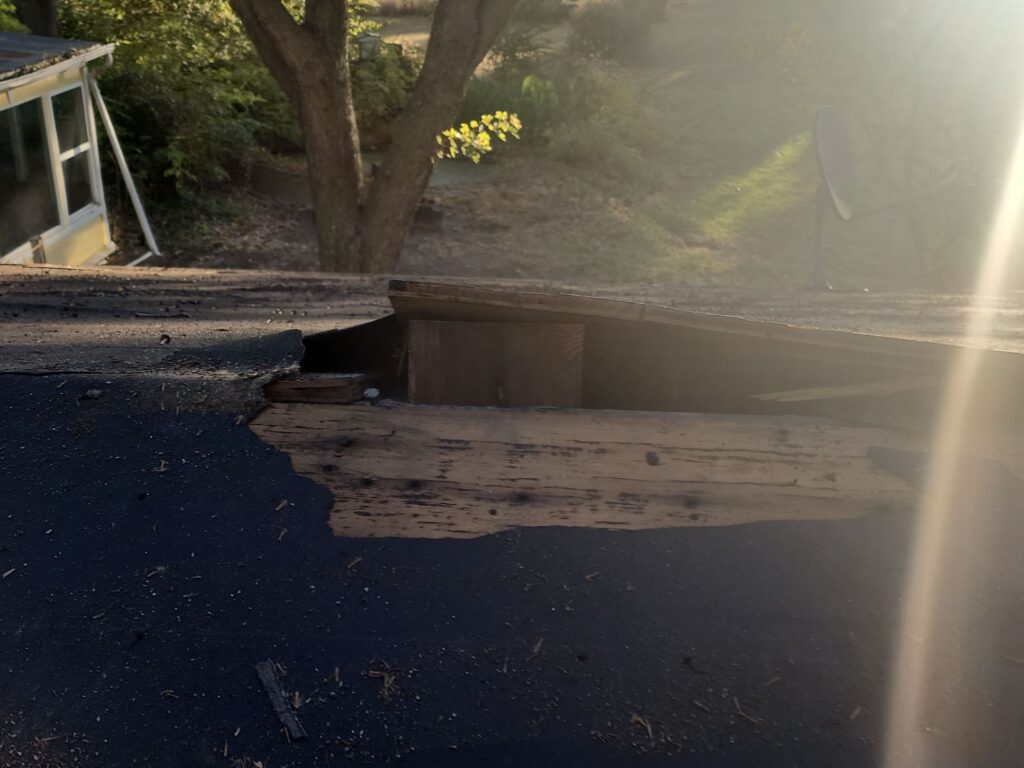
Severe buckling at the eaves of a house we found during a roof replacement. Buckling occurs at the seams between boards of roof decking. It can occur when plywood swells with moisture, but no moisture damage is present in this photo. This suggests that the deck buckled as a result of thermal expansion from inadequate ventilation.
Buckling
- Cause: Buckling occurs when roof decking expands from excessive heat or moisture retention but has no room to move, forcing one board to lift and slip over another.
- Effect: This creates visible ridges that break shingle lines, pull out fasteners, and compromise the adherence of any ice and water shield present. Decking is the foundation of the roof, and its effects cascade up similarly. Foundation shifting can spiderweb your plaster; a buckled roof deck affects the home’s main weather barrier, its roof, so buckling tends to have more immediate consequences for shingles and water management.
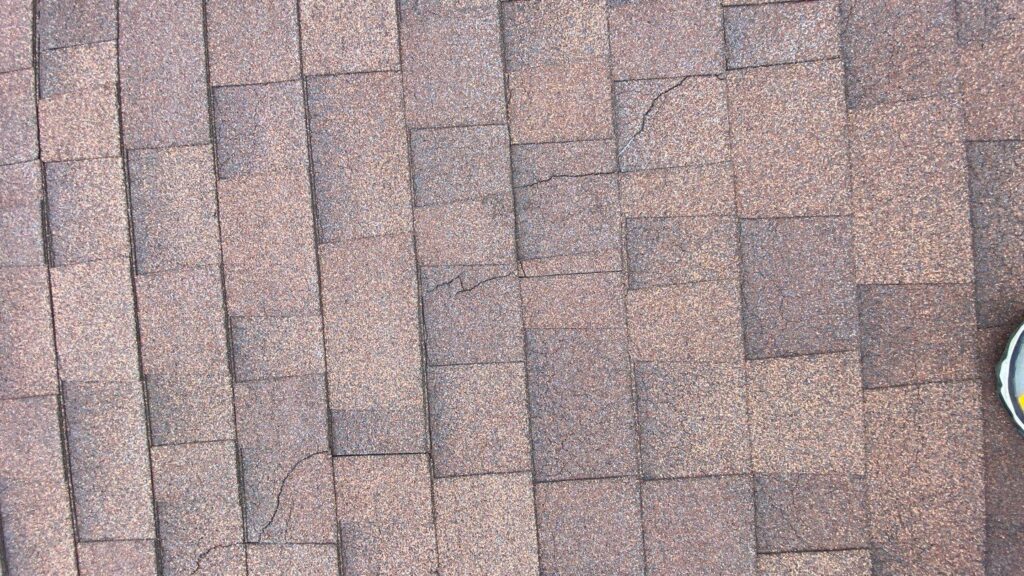
Severe cracking on field shingles can occur after prolonged exposure to excessive attic temperatures. Unlike standard degranulation, cracked shingles have been split at the fiberglass matting. This creates a direct path for water through the shingle.
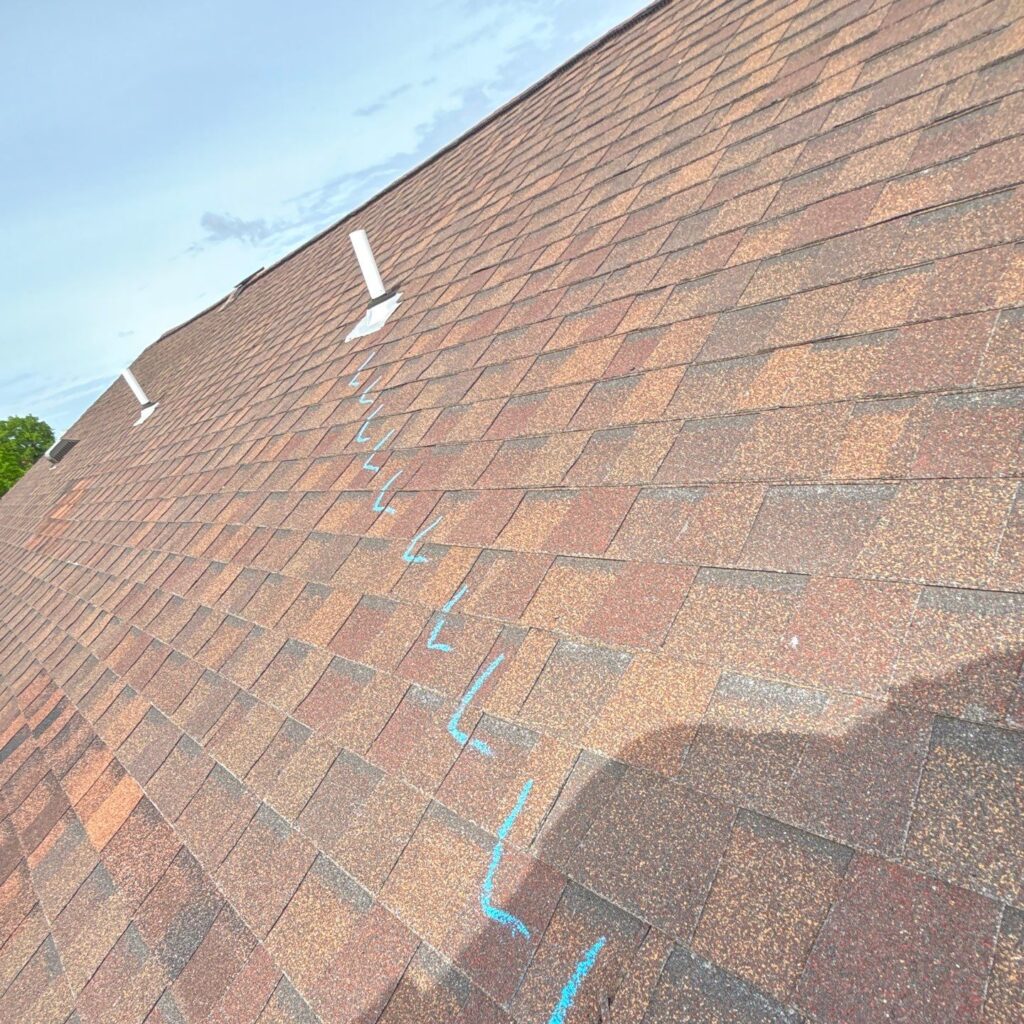
Zippering Chalked on Asphalt Shingle

Zippering on an Asphalt Shingle Roof
Cracking
- Cause: Over time, roofing materials expand and contract with temperature changes, a phenomenon called thermal expansion. An underventilated attic space intensifies this process because it doesn’t help regulate the temperature, resulting in destructive thermal cycling.
- Effect: The stress of unregulated thermal expansion produces cracks in the shingles, opening a path for water infiltration and making them more likely to blow off in response to strong winds. These temperature swings can also produce zippering, partially lifted shingles at a diagonal along the roof’s surface. While it may look like wind damage, zippering is more commonly caused by weakened shingle securement due to thermal expansion. Once zippering has occurred, wind uplift can simultaneously blow off large sections of shingles.

Bubbling shingles occurs in underventilated roof systems. The bubbles are created by the release of VOCs, or chemical gasses, in the shingle. When the bubbles pop, it creates blisters that expose the fiberglass matting of the shingles.
Blistering
- Cause: Ventilated attics push heat through the attic space and pull cooler air in from intake vents below. Without effective passive ventilation, hot air rises and accumulates against the roof decking, generating radiant heat that permeates the deck and shingles above. In the summer, when UV radiation is heating shingles from above and radiant heat warms them from below, shingles begin releasing gas that can 1) get trapped, forming bubbles, or 2) pop, creating blisters.
- Effect: Blisters expose the fiberglass matting underneath the granules. Granules protect other shingle layers from UV radiation and hail impacts. Once they pop off, the matting is unprotected, while the resulting crater from the blister can invite water.
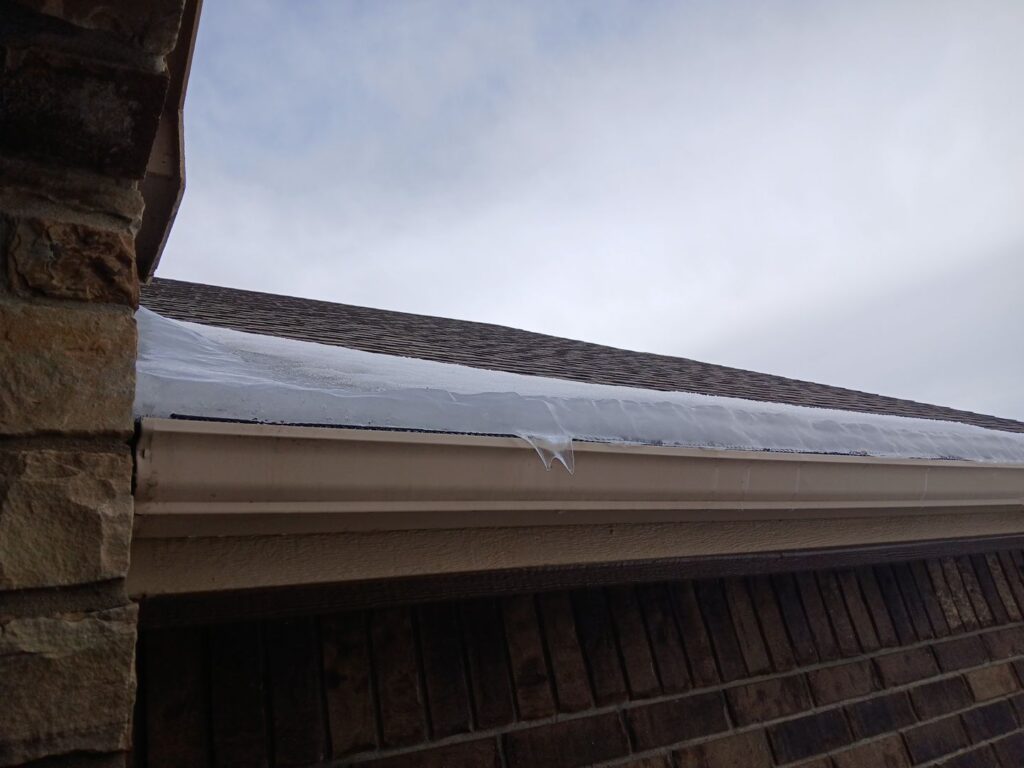
Ice Dams and Winter Roof Leaks
- Cause: Proper attic ventilation keeps the attic space near the outdoor temperature. If the attic is warmer than the temperature outside in the winter, snow on the roof will melt, while snow on the eaves remains frozen. Snowmelt accumulates behind the ice formed at the eaves, resulting in standing water that sloped roofs are not designed to handle.
- Effect: Ice dams result in interior leaks and rotted roof decking, among other issues. For a deeper dive, see our full article on ice dam formation and prevention.
Condensation on Structural Members
- Cause: People produce moisture by existing. Sweat is a clear, wet example of this. A less visible but more significant example of this is exhalation. That’s the reason you can see your breath when it’s cold outside: moisture in your breath condenses into droplets of water. Not to mention showers, cooking, laundry, running the dishwasher – all of it produces moisture, and this moisture can be carried into the attic.
- Effect: Without proper attic ventilation moisture remains in the attic, where it condenses in the winter just like it does when you exhale. Moisture can enter the attic from the exterior when it’s humid, too. No matter where it enters from, passive ventilation from proper attic ventilation will exhaust it, preventing moisture accumulation and condensation.

Mold proliferating from the underside of the roof deck to the structural members of a sloped roof, visible from the attic space.
Mold and Health Risks
- Cause: Moisture retention in your attic does the same thing as moisture retention in your pantry. Instead of producing mold on a slice of bread, it will produce mold on roof decking and wood rot on structural members.
- Effect: Once mold spores form on attic wood, it will proliferate and circulate through HVAC systems, worsening asthma, allergies, and general indoor air quality. Additionally, the persistent musty odor of older homes, often referred to as the “old house smell,” is often indicative of underlying moisture problems.
Poor Thermal Performance
- Cause: Step into an attic on a hot summer day and your survival instinct will tell you the problem immediately: attics can get hot, and they get hot quickly. Without ventilation to push that hot air out of the attic, the heat will permeate your living space. This can result in top-floor rooms with unusually warm temperatures.
- Effect: This retained heat belabors your air conditioner and can drive up energy costs by up to 10 percent, according to the Florida Solar Energy Center. Energy savings will vary, but proper attic ventilation substantially improves the attic’s thermal performance. Upstairs rooms are likely to feel cooler with a properly ventilated attic space as a result.
Pests in the Attic
- Cause: Warm, damp, and stagnant spaces attract pests because it mimics a protected shelter for them. Birds, rodents, bats, and insects nest in similar environments outside. If your attic provides a similar environment with virtually no natural predators, they will find their way in through intake vents, interior walls, dryer vents, siding – any remote access point can be used.
- Effect: These pests damage insulation, wiring, and even structural wood. They are awake at unwieldly hours and they don’t ask before eating insulation or wood — they’re terrible tenants, and proper attic ventilation makes the space less hospitable for them.
Preclusion from Manufacturer Warranties
Parking near cart corals in grocery store parking lots can be viewed as an unnecessary risk. Roofing manufacturers see inadequate attic ventilation the same way. Roofing manufacturers like GAF will not extend a manufacturer’s warranty if their materials are installed over an improperly ventilated attic. The way GAF sees it, if its products are liable to suffer from the issues cited above – blistering, buckling, cracking, deteriorated structural members, pest infiltration, and ice dams – why would they extend a warranty and assume responsibility for those preventable damages?
Proper attic ventilation is a prerequisite for manufacturer’s warranties, building code, and a long-lasting roof system. But that hasn’t always been the case. For much of the 20th century, roofs were just considered a protective cover, not a system with multiple parts working in balance. Understanding how we arrived at today’s standards, and why ventilation became a code requirement, provides context for the ventilation issues many homeowners face today.
A Historical Look at Ventilation
Trapped heat and moisture have influenced how people build for thousands of years. A roof keeps rain out, but it’s also responsible for regulating the enclosed attic structure beneath it. Before building code defined best practice, solutions came from observation, trial, and guesswork. Building code might not have existed a thousand years ago, but physics certainly did. By examining how builders in the past approached ventilation, we can better understand both the science behind it and the reasons today’s ventilation standards exist.
| Time Period/Culture | Problem | Solution | Shortcoming |
|---|---|---|---|
| Ancient Egypt | The desert was hot and lacked natural airflow through Egypt’s thick-walled mudbrick structures, which retained heat and kept them warm during cold desert nights. During the day, however, interior spaces were untenably warm. | Ventilated structures were designed with high ceilings and narrow openings to allow hot air to rise and escape, and clerestory windows near the top of walls allowed some air movement. Some Egyptians used evaporative cooling methods, like wet reed mats over entryways, to cool living spaces. | While they were used primarily for their light, clerestory windows allowed hot air to exhaust in many Ancient Egyption homes. However, clerestory windows and evaporative cooling were dependent on wind direction, humidity, and clerestory windows could only be used on taller structures. Rooms and courtyards were ventilated, not enclosed roof cavities like today’s attics. In other words, they provided periodic comfort, but didn’t produce consistent, balanced intake and exhaust through the functional equivalent of a modern attic, nor did they prevent sand infiltration. |
| Ancient Rome | “Insulae,” the common person’s living space, resembled the wall of a hive, with everyone squished together and few rooms with exterior walls. To stay warm, inhabitants would light fires in their rooms anyway. | Public buildings and villas used atriums and “impluviums,” central open-air courtyards that vertically circulated air. Similarly, “tubuli,” pipes through which warm air circulated behind the walls, and “hypocausts,” the heating system beneath floors, addressed discomfort caused by poor ventilation. | The solutions cited weren’t available for standard romans living in insulae. They were airless and smoky. Tubuli required substantial upkeep, while hypocausts heated the area more than ventilated it – again, treating the symptom without knowing the exact cause. As a result, they often caused fires and carbon monoxide poisoning. |
| Medieval Europe | Unfortunately for Medieval Europe, drafts don’t count as purposeful ventilation. Houses were not built airtight. Fireplaces vented smoke through holes in the roof, so smoke often lingered near the ceiling without purposeful air intake. Damp conditions led to rotting structural members and respiratory illness. | Ventilation was achieved passively, or accidentally, through cracks in walls, thatched roofing, and basic chimney stacks. Large halls often had louvered roof openings that allowed smoke to escape. In fact, tapestries were often hung to stymy drafts. Why wear a blanket when you can hang it on the wall to keep you warm? | Building construction enabled smoke to escape, but fresh air wasn’t (purposefully) drawn in. All ventilation was unbalanced. Airflow as an architectural feature didn’t exist – it was just necessary to avoid suffocation. They believed that air circulation could cause illness, a belief rooted in miasma theory. |
| Industrial Revolution | There was no standardized method for ventilation in factories or homes. This presented a problem with the advent of coal-burning stoves and gas lighting, resulting in respiratory illnesses such as tuberculosis. | Roof vents were used, and transom windows helped promote cross-ventilation, which was encouraged by building design manuals at the time. Mechanical ventilation was also used, but it was costly to run. | Similar to the ventilation methods of Ancient Egypt, the cupolas and large windows used as exhaust required wind to function. Lofts and attics, unlike living spaces, still received no passive ventilation. Also similar to Ancient Egypt was the presence of debris. Debris was composed mainly of soot from industrial processes, which was liable to buildup and effectively reduce the available NFA by gumming up the works. Ventilation continued to exist primarily to address occupant comfort, not preserve the structural integrity of the building. |
Reed mats in ancient Egypt, atriums in Rome, and louvered roof openings in Medieval Europe were designed to improve comfort. These systems managed smoke, heat, and breathable air. They didn’t manage moisture. This wasn’t a significant problem for structural integrity at the time, as thatched roofs, wood shingles, or slate laid over spaced lathing were naturally porous. They leaked both air and moisture, which meant that enclosed spaces rarely experienced the condensation issues that modern attics do. Builders addressed comfort, not condensation. Construction methods changed near the beginning of the 20th century, and so did everything builders knew about ventilation up to that point.
How Attic Ventilation Evolved from Trial and Error to Code
As materials evolved, roofs evolved too: they went from permeable layers to sealed systems. Asphalt shingles were introduced in the early 20th century, and they required continuous decking rather than open lath or spaced decking. This stopped roofs from “breathing.” This led to a new challenge: warm, saturated interior air began accumulating in attics, resulting in condensation on cold surfaces in the winter and overheating beneath the now-continuous roof deck in the summer. Symptoms of moisture retention in attic spaces immediately started appearing.
By the 1930s, painters began complaining about peeling paint on gable ends. They correctly suspected that trapped moisture was responsible, though the FHA initially dismissed continuous sheathing as a cause. Cupolas and gable vents, which were originally used to exhaust barn odors, were adapted to exhaust attic moisture in attic spaces.
By the 1940s, builders began to realize that ventilation wasn’t optional. In 1942, today’s 1:300 rule was introduced – one square foot of NFA for every 300 square feet of attic floor. The rule wasn’t particularly scientific at the time, but it acknowledged a need: once roofs are sealed with solid decking and bitumen-based materials, air no longer escaped on its own. From then on, airflow had to be designed purposefully into the roof system.
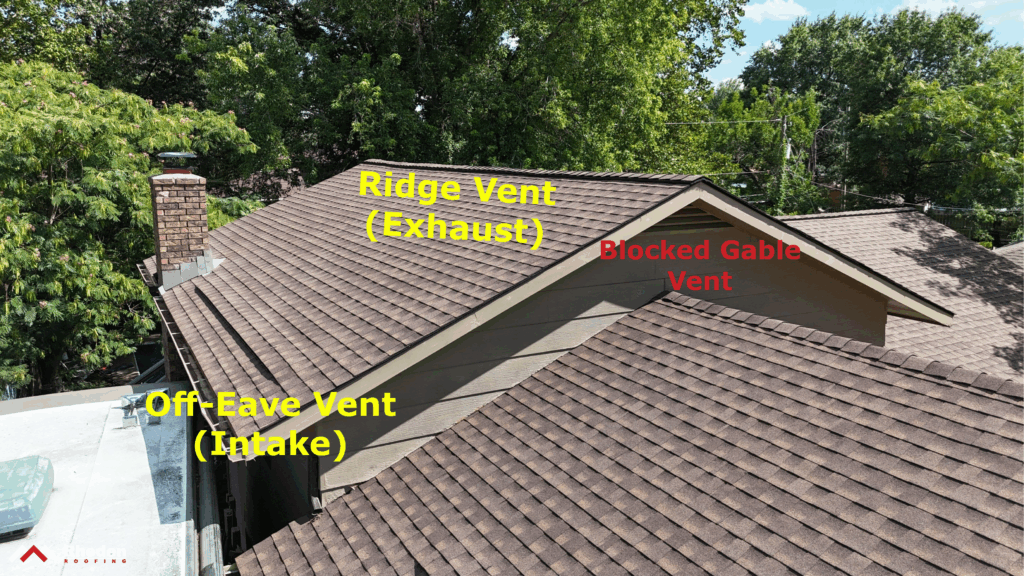
Modern Attic Ventilation Guidelines
The trial and error performed by builders in the past has directly informed modern building code. Now that we understand why proper attic ventilation is so important, let’s review the key principles that keep attics healthy and roofs intact.
- Adequate Ventilation (1:300 rule): Ensures every attic has enough air flow to prevent moisture accumulation (condensation) and heat buildup.
- Prevents: The moisture damage that occurred when solid roof decking caused a buildup of humid air in the 1930s.
- Balanced Intake and Exhaust (60:40 ratio of intake and exhaust): Creates passive ventilation, drawing air in at the lowest points in the attic and pushing it out near or at the top of the roof.
- Prevents: Exhaust vents can pull air from conditioned spaces due to negative pressure if intake and exhaust are not properly balanced.
- Avoid Mixing Exhaust Types/Heights: A common example of this is gable vents paired with ridge vents.
- Prevents: “Short-circuiting,” where one exhaust vent begins drawing in air for another exhaust vent, creating “dead zones” – areas where no airflow is present.
The three guidelines above represent modern building code, but there are many more considerations, like what type of attic you have, your attic insulation’s location, and whether or not the building is a conditioned space. To identify the ventilation system your house or building uses, check out our article What Type of Attic/Roof Ventilation System Do I Have?
This article is part of our ‘Roof Component Inspection & Service Life’ Series. Learn more about:
Flashing
Roof Vents

